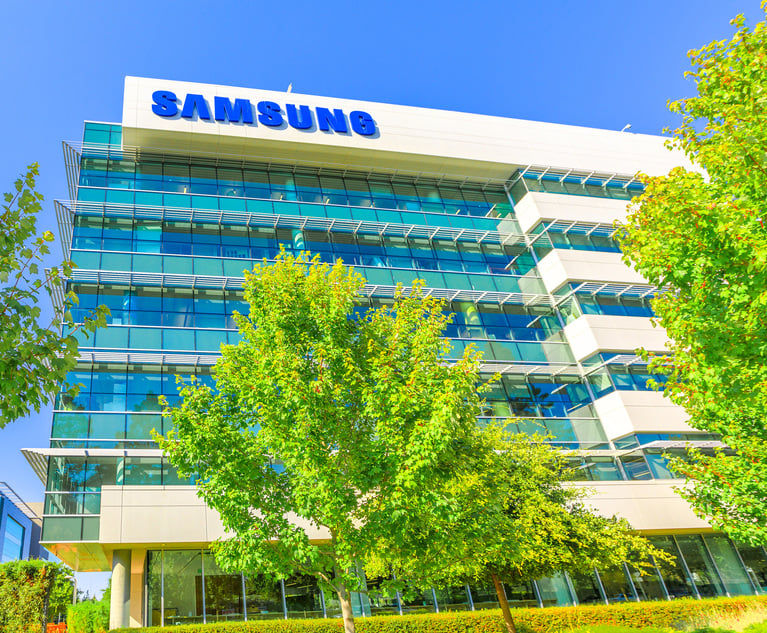Workers' Rights
Employee inventions may lead to patent battles with employers.
May 31, 2008 at 08:00 PM
6 minute read
In 1990, David Barstow was pursuing a dream. By day, he wrote computer code for the oil and gas drilling operations of his employer Schlumberger Technology Corp. At night and on weekends, he worked with his brother Daniel on a very different project: software that would produce computer simulations of live sporting events.
As the years passed, the brothers' continuing work seemed to be successful, and they ultimately received four patents on their technology.
In 1994, David lost his job at Schlumberger and went into business for himself. He and Daniel set up DDB Technologies with high hopes of commercializing their sports software.
David's dream, however, slowly turned into a nightmare. His company's efforts to make and sell the software didn't go well. Attempts to license the four patents resulted in just one licensee, SportsLine.com.
But according to Michael Gannon, an IP attorney at McDonnell Boehnen Hulbert & Berghoff, many other Web sites, including Major League Baseball's Web site, are using the Barstows' patented technologies. Gannon represents DDB.
So DDB, to which David and Daniel assigned their patent rights, filed a patent infringement suit in 2004 against MLB Advanced Media (MLBAM), which operates Major League Baseball's Web site. MLBAM fought DDB for almost two years.
Then in April 2006, the company purchased the right to use the patents–but not from DDB. Schlumberger, asserting that it owned David's rights in the patents, sold those rights to MLBAM along with a retroactive patent license. Now David risks losing all his patent rights to MLBAM. And he is suing Schlumberger for fraud.
This case underscores the problems that can arise when employees create inventions. “It's typical for an employee to create an invention, think he owns it and leave the company without getting any clarity about who [really] owns it,” says James M. Matulis, an IP attorney at Fowler White Boggs Banker. “This is a cautionary tale.”
Patent Peril
Like many businesses, Schlumberger uses employment agreements that specify when the company owns employees' inventions. Schlumberger's agreement with David, however, was broader than most. It gave the company ownership of all employee inventions that “relate in any way” to Schlumberger's business or “are suggested by” any work the employee did for Schlumberger.
David claims his sports-related software had nothing to do with his work for the company. Schlumberger initially agreed. While David was working on his invention, both Charles Huston, Schlumberger's general counsel for software matters, and Dr. Reid Smith, the director of the lab in which David worked, stated that the sports software belonged to David, not Schlumberger. However, 16 years after the first patent application was filed and 12 years after David had left the company, Schlumberger changed its mind. It asserted that it owned all of David's rights in the inventions.
A Texas federal court agreed, ruling in September 2006 that the sports software was “related to” and “suggested by” David's work for Schlumberger. When Schlumberger sold its rights in the software to MLBAM, MLBAM became a co-owner of the relevant patents (along with David's brother Daniel). As co-owner, MLBAM had the legal right to use the patented software. So the court threw out DDB's infringement suit against MLBAM.
DDB appealed and got a slightly better result from the Federal Circuit.
Who Knew?
A three-judge panel ruled in February that DDB's suit should not be tossed out yet, saying it was too soon to decide that David had assigned the patents to Schlumberger. Extrinsic evidence was needed to determine whether the patents at issue were “related to” or “suggested by” David's work for Schlumberger, the court ruled. And the parties' views at the time the inventions were created were “highly relevant, if not dispositive” of this issue, the court held.
The ruling is a big help to David, since two key Schlumberger officials had originally concluded that the company didn't own the inventions. “This was a huge signal to the district court judge that unless Schlumberger did something to make people think the inventions belonged to the company, the inventions belong to David Barstow,” says Paul Devinsky, an IP attorney at McDermott Will & Emery.
On the other hand, the Federal Circuit noted that the two Schlumberger officials' conclusion would be relevant only if David had fully informed the officials about his project. “The crucial question thus was the extent of Schlumberger's knowledge of the project at the time,” the court stated.
The Federal Circuit ordered that DDB be allowed to conduct additional discovery of Schlumberger to see if DDB could uncover any records concerning “the extent of the company's knowledge of the inventions” as well as evidence on “whether Schlumberger's officers or employees believed that Schlumberger had an ownership interest in those inventions.”
Cover Your Assets
“This case should give everyone a moment of concern about what our
people are doing, on both sides of employer-employee relationships,” says Jeffrey Lewis, a patent litigator at Patterson Belknap Webb & Tyler. “Either the employee didn't give the employer enough information about the invention, or the employer gave away its property rights without proper review.”
To avoid this situation, both employers and inventive employees need to formalize the process for submitting and reviewing employee inventions. Inventors should provide company officials with full descriptions of their personal projects, and they should do this in writing. “Set down a paper trail,” Matulis says.
Companies should set up internal mechanisms for reviewing employees' inventions and determining whether the company owns those inventions.
“Designate a person who will give waivers and include in the employment agreement the process for getting waivers. That will standardize corporate practices,” Lewis says. “This will avoid ad hoc conversations between an employee and manager, where the company's rights might be harmed by something the manager casually says.”
Putting a review process in place, however, may be easier than executing it. “Most companies will not be happy to make a decision on whether or not they own something,” Devinsky says.
“If an employee waits for the eventual decision, he might wind up losing the right to apply for a patent.”
This content has been archived. It is available through our partners, LexisNexis® and Bloomberg Law.
To view this content, please continue to their sites.
Not a Lexis Subscriber?
Subscribe Now
Not a Bloomberg Law Subscriber?
Subscribe Now
NOT FOR REPRINT
© 2025 ALM Global, LLC, All Rights Reserved. Request academic re-use from www.copyright.com. All other uses, submit a request to [email protected]. For more information visit Asset & Logo Licensing.
You Might Like
View All
Best Practices for Adopting and Adapting to AI: Mitigating Risk in Light of Increasing Regulatory and Shareholder Scrutiny
7 minute read
FOMO Run Amok? Resolve of Firms Chasing AI Dreams Tested by Sky-High Costs


Trending Stories
- 1The Appropriate Exemption in Students for Fair Admissions v. President & Fellows of Harvard College
- 2DOJ, 10 State AGs File Amended Antitrust Complaint Against RealPage and Big Landlords
- 3New Partners at Cummings & Lockwood, Carmody Torrance Sandak & Hennessey
- 4'Extra Government'?: NY Top Court Eyes Ethics Commission's Constitutionality
- 5South Texas College of Law Houston Selects New Dean
Who Got The Work
Michael G. Bongiorno, Andrew Scott Dulberg and Elizabeth E. Driscoll from Wilmer Cutler Pickering Hale and Dorr have stepped in to represent Symbotic Inc., an A.I.-enabled technology platform that focuses on increasing supply chain efficiency, and other defendants in a pending shareholder derivative lawsuit. The case, filed Oct. 2 in Massachusetts District Court by the Brown Law Firm on behalf of Stephen Austen, accuses certain officers and directors of misleading investors in regard to Symbotic's potential for margin growth by failing to disclose that the company was not equipped to timely deploy its systems or manage expenses through project delays. The case, assigned to U.S. District Judge Nathaniel M. Gorton, is 1:24-cv-12522, Austen v. Cohen et al.
Who Got The Work
Edmund Polubinski and Marie Killmond of Davis Polk & Wardwell have entered appearances for data platform software development company MongoDB and other defendants in a pending shareholder derivative lawsuit. The action, filed Oct. 7 in New York Southern District Court by the Brown Law Firm, accuses the company's directors and/or officers of falsely expressing confidence in the company’s restructuring of its sales incentive plan and downplaying the severity of decreases in its upfront commitments. The case is 1:24-cv-07594, Roy v. Ittycheria et al.
Who Got The Work
Amy O. Bruchs and Kurt F. Ellison of Michael Best & Friedrich have entered appearances for Epic Systems Corp. in a pending employment discrimination lawsuit. The suit was filed Sept. 7 in Wisconsin Western District Court by Levine Eisberner LLC and Siri & Glimstad on behalf of a project manager who claims that he was wrongfully terminated after applying for a religious exemption to the defendant's COVID-19 vaccine mandate. The case, assigned to U.S. Magistrate Judge Anita Marie Boor, is 3:24-cv-00630, Secker, Nathan v. Epic Systems Corporation.
Who Got The Work
David X. Sullivan, Thomas J. Finn and Gregory A. Hall from McCarter & English have entered appearances for Sunrun Installation Services in a pending civil rights lawsuit. The complaint was filed Sept. 4 in Connecticut District Court by attorney Robert M. Berke on behalf of former employee George Edward Steins, who was arrested and charged with employing an unregistered home improvement salesperson. The complaint alleges that had Sunrun informed the Connecticut Department of Consumer Protection that the plaintiff's employment had ended in 2017 and that he no longer held Sunrun's home improvement contractor license, he would not have been hit with charges, which were dismissed in May 2024. The case, assigned to U.S. District Judge Jeffrey A. Meyer, is 3:24-cv-01423, Steins v. Sunrun, Inc. et al.
Who Got The Work
Greenberg Traurig shareholder Joshua L. Raskin has entered an appearance for boohoo.com UK Ltd. in a pending patent infringement lawsuit. The suit, filed Sept. 3 in Texas Eastern District Court by Rozier Hardt McDonough on behalf of Alto Dynamics, asserts five patents related to an online shopping platform. The case, assigned to U.S. District Judge Rodney Gilstrap, is 2:24-cv-00719, Alto Dynamics, LLC v. boohoo.com UK Limited.
Featured Firms
Law Offices of Gary Martin Hays & Associates, P.C.
(470) 294-1674
Law Offices of Mark E. Salomone
(857) 444-6468
Smith & Hassler
(713) 739-1250






